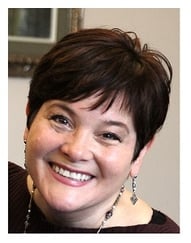Posted by Caveo Learning ● October 6, 2015
L&D Manager on Benefits of Social Learning, Keys to Change Management
 This is part of our ongoing series, Interviews with Learning Leaders.
This is part of our ongoing series, Interviews with Learning Leaders.
DeAnna Myers is the learning & development manager for Sargent & Lundy, an Illinois-based engineering and design firm specializing in power generation and transmission projects. DeAnna developed and implemented Sargent & Lundy's first in-house training department, tasked with training more than 2,500 engineers, designers, and technical support personnel. DeAnna began her Sargent & Lundy career as the fossil power operations manager, and resulting from her organization skills and understanding of the business needs of the organization, she was asked to form the training department. She holds a master's in learning and organizational change from Northwestern University.
How has learning & development evolved at Sargent and Lundy?
The scope of our group has evolved over time. Right now, I would say that we have a maturing training model. I have found the progression we experienced to fairly common in the formation of a training department. We first focused on expediting logistics and making sure classes were delivered. We then came to the realization that our audiences became more diverse alongside their training needs.
We needed to focus on different areas like technical skills, technology, and more specifically job/position- based learning. We naturally fell into the task of establishing competencies—or as we like to call them, learning plans. Eventually, we began to see learning best practices emerge. It is a natural evolution, and we are building capability at different levels for different jobs. We have core curricula for each discipline and role.
With the other skills addressed, we are now transitioning to performance-focused solutions. We find ourselves more frequently playing the role of consultant or change manager, versus order taker. We can look at increasing performance and efficiency. The maturation of our training model grew from low-hanging fruit to high-reaching performance and leadership solutions.
What learning trends do you see as being valuable?
I love the collaborative learning trend, and social platforms for collaboration. There is great value in social learning, particularly for those who often don’t come by “social” naturally. The challenge for social learning in a billable environment is overcoming the perception of a social platform as being a time-waster. In our case, we focused on the organization’s communities of practice around important, relevant topics like combustion turbines or mechanical systems design. By focusing on hot topics, we took the emphasis away from the individual. We created spaces for the topics and have assigned subject matter experts for each topic. It has taken off. Experts have a chance to share with more junior staff. They can answer questions like, “Why is this happening?” and “How did you do this on the project?”
I believe social learning will become more important than the LMS over time—it makes the learning relevant, allowing learning to be “pulled,” instead of pushing training at them. The platform enables experts to address problems in one office and to solve them across locations and projects. It helps with adoption of new software and makes newer regionals feel part of the mix. It is a true success story.
And a side note on this topic: an established learning path can minimize critical thinking. By designing a curriculum, the learner can be set on autopilot. We push it at them and obliterate the pull. Leaving some flex in the learning model makes the learner continue to think of possibilities and what they need, versus receiving the pushed curriculum. Learning at that point truly becomes “on demand.”
Do you face any audience-specific challenges?
We, like most consulting firms, battle billable versus learning hours. All staff are billable. Time away from projects can compete with billable time. So we chunk things into smaller segments, which can actually be beneficial to learning—spacing out the discussion. We are very careful to ensure that neither billable hours nor the opportunity to build expertise suffer. This is critical to our busy, client-focused staff.
What has been the benefit of having an advanced degree?
My master's has been pivotal in understanding how change happens—what it will take to change behaviors in adults, and what it will take to build behaviors that subsequently build profit. The real learning is helping people—individuals—change behaviors. Many talk about change at the organizational level, but it is really more important to understand it at an individual level and the process of building on success to create change in an organization.
Do you have any advice for others in the L&D industry?
Be patient with the evolution as you move things ahead. Meet internal clients where they truly are, versus where you want them to be. Take time to build your credibility through trust, and get comfortable with small steps—they may mean more than you anticipate. Finally, when implementing blue-sky change, consider your organization’s culture and how receptive they are to change. You may find that several small changes scheduled in sequence are easier to implement than one large, sweeping change; it may be best to make it evolutionary.
Topics: Interviews with Learning Leaders
